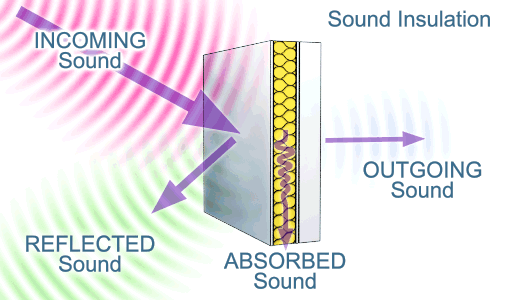Sound absorption refers to the process by which a material, structure, or object takes in sound energy when sound waves are encountered, as opposed to reflecting the energy. Part of the absorbed energy is transformed into heat and part is transmitted through the absorbing body. The energy transformed into heat is said to have been “lost”…
For example, when sound from a loudspeaker collides with the walls of a room part of the sound’s energy is reflected, part is transmitted, and part is absorbed into the walls. Just as the sound energy was transmitted through the air as pressure differentials (or deformations), the sound energy travels through the material which makes up the wall in the same manner. Deformation causes mechanical losses via conversion of part of the sound energy into heat, resulting in sound attenuation, mostly due to the wall’s viscosity. Similar attenuation mechanisms apply for the air and any other medium through which sound travels.
The fraction of sound absorbed is governed by the acoustic impedances of both media and is a function of frequency and the incident angle. Size and shape can influence the sound wave’s behavior if they interact with its wavelength, giving rise to wave phenomena such as standing waves and diffraction.
Sound absorption is of particular interest in room acoustics. Acousticians aim to absorb as much sound energy (often in particular frequencies) as possible converting it into heat or transmitting it away from a certain location. In general, soft, pliable, or porous materials (like towels) serve as good sound insulators – absorbing most sound, whereas dense, hard, impenetrable materials (such as metals) reflect most. In layman’s terms by treating a room’s acoustics, you are helping reduce the “echo” or “reverberation” of the room. This helps with speech intelligibility as well as the overall “loudness” in a room. Have you ever been in a busy restaurant or shopping mall and it is so loud that you cant even hear the person next top you talking? Places like this need to have the room treated for better sound absorption!
How well a material absorbs sound is quantified by the effective absorption area of the material, and this is called the Noise Reduction Coefficient or NRC. NRC is a scalar representation of the amount of sound energy absorbed upon striking a particular surface. An NRC of 0.0 indicates perfect reflection; an NRC of 1.0 indicates perfect absorption. Due to the formulas used, the coefficient is not a percentage and values larger than 1.0 are possible (and common). Here is a list of common materials and there respective NRC’s over the 6 frequency bands listed:
| MATERIALS | COEFFICIENTS | |||||
| 125 hZ | 250 hZ | 500 hZ | 1000 hZ | 2000 hZ | 4000 hZ | |
| Brick | .03 | .03 | .03 | .04 | .05 | .07 |
| Carpet on concrete | .02 | .06 | .14 | .37 | .60 | .65 |
| Carpet with heavy pad | .08 | .24 | .57 | .69 | .71 | .73 |
| Carpet with Impermeable backing | .08 | .27 | .39 | .34 | .48 | .63 |
| Concrete block (course) | .36 | .44 | .31 | .29 | .39 | .25 |
| Concrete block (painted) | .10 | .05 | .06 | .07 | .09 | .08 |
| Light fabric | .03 | .04 | .11 | .17 | .24 | .35 |
| Medium fabric | .07 | .31 | .49 | .75 | .70 | .60 |
| Heavy fabric | .14 | .35 | .55 | .72 | .70 | .65 |
| Concrete, marble or glazed tile | .01 | .01 | .015 | .02 | .02 | .02 |
| Wood | .15 | .11 | .10 | .07 | .06 | .07 |
| Heavy glass | .18 | .06 | .04 | .03 | .02 | .02 |
| Ordinary glass | .35 | .25 | .18 | .12 | .07 | .04 |
| Gypsum board 1/2″ | .29 | .10 | .05 | .04 | .07 | .09 |
| Plaster | .013 | .015 | .02 | .03 | .04 | .05 |
| Water surface | .008 | .008 | .013 | .015 | .020 | .025 |
Typical acoustic panels and baffles that Hush City soundproofing use have far higher NRC’s than most of the materials on this list. These type products have NRC that range anywhere from 0.60 to 1.20. And as much as people would like to use blankets or towels on there walls to absorb sound, they wont do as good of a job as acoustic panels or baffles will. It also depends on the frequencies you are trying to absorb as well. Some acoustic panels do a better job absorbing low frequencies (60-125 hZ) than others do, so always ensure you know which frequencies you are dealing with before spending money on a product that may not work. Remember you can always contact an expert at Hush City soundproofing to assist you with your sound absorption needs!
Share blog:
Sharing is caring!!

